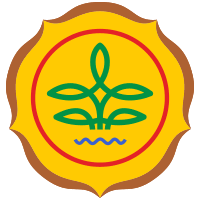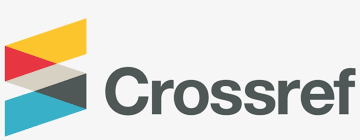Identifikasi Spesies Nematoda Meloidogyne sp pada Tanaman Tomat (Solanum lycopersicum L) dan Seledri (Apium graveolens L) di Samarinda
Abstract
species that attack tomato and celery plants. The locations are in Lempake and in Sambutan, Samarinda city, East
Kalimantan. Identification of nematode species is based on morphometric and perennial parten characteristics. Nematode
extract was performed by root stenning method and nematode surgery. The result showed that there was one species
(Meloidogyne javanica) of nematode at root of tomato and celery plant in Lempake, while in Sambutan showed that there
were two species of Meloidogyne, they are Meloidogyne javanica and Meloidogyne incognita. Based on this research showed
that nematodes Meloidogyne are the most enermoust nematodes on tomato and celery plants in Samarinda.
Keywords
Full Text:
PDFReferences
Abawi, G, S and Widmer. 2000. Impact Of Soil Health Management Practices On soil Borneo Pathogens, Nematodes and Root Disease Of Vegetable Cropas. Applied Soil Ecology 15:37-47.
Agrios G. N. 2005. Plant Pathology. Edisi ke-5. New York: Academic Press.
Ambarwati, E., G. A. P. Maya, S. Trisnowati, dan R. H. Murti. 2012. Mutu buah tomat dua galur harapan keturunan ‘GM3’ dengan ‘Gondol Putih’.Proseding Seminar Nasional Hasil Penelitian Nasional.
Amin, B. 2007. Host and Temperature Preference, Male Occurrence and Morfometrics of Fungivorous Nematoda. Aphelenchus avenae Isolates from Japan. Jurnal Agripet. Vol.7.
Bernadius dan W. Wahyu. 2008. Bertanam Tomat. Jakarta: PT Agro Megia pustaka.
Bio Intellegence Service (BIS), Europe Commision. 2010. Soil Biodiversity: Functions, Threats and Toolsfor Policy Makers.Technical Reports 2010. Tersedia di: www.biois.com/soilbiodiversity/231html.
Burelle NK, Rosskopf EN. 2012. Susceptibility of several common subtropicalweeds to Meloidogyne arenaria, M incognita and M javanica. Journal Nematol. 44(2):142-147.
[CABI] Central for Agriculture and Biosciene International. 2007. Crop Protection Compendium. Wallingford (US): CAB International.
Cahyono, B. 1998. Tomat Budidaya dan Analisis Usaha Tani. Kanisius, Yogyakarta.
Castillo, M. B. 1991. Manual in genera Identification of Plant nematodes. College Agriculture University of The Philipines. Los Baros College. Laguna. Philipines.
Castillo, P., Vovlas, N., Troccoli, A. 2003. The Reniform Nematode, Rotylenchulus macrosoma, Infecting Olivebin Southern Spain. Jurnal Nematology. Vol.5 (1) : 23-29.
Disbun Kaltim. 2014. Rekapitulasi Luas Areal dan Produksi Pola Perkebunan Besar Swasta. Katalog DISBUN. Dinas Perkebunan. Samarinda. http://Dinas Perkebunan Kalimantan Timur. 17 November 2016.
Disbun Kaltim.2016. Rekapitulasi Luas Areal dan Produksi Pola Perkebunan Besar Swasta. Katalog DISBUN. Dinas Perkebunan. Samarinda. http://Dinas Perkebunan Kalimantan Timur. 17 November 2016.
Djaenudin, D., Marwan H., Subagjo H., Hidayat, A. 2003. Petunjuk Teknis Evaluasi lahan Untuk Komuditas Pertanian. Balai Penelitian Tanah Pusat dan Pengembangan Tanah dan Agroklimat Badan Penelitian dan Pengembangan Pertanian, Departemen Pertanian Bogor. 30 halaman.
Djiwati, S. R.., Supriadi. 2008. Determinasi Nematoda Parasit Aphelenchoides sp. Penyebab Penyakit Hawar Daun Sambiloto (Andrographis paniculata). Jurnal Littri. Vol.4 (2):61-66.
Dropkin. V. H. 1996. Pengantar Nematologi Tumbuhan. Gadjah Mada University Press. Yogyakarta.
Durahman, D., Tarno, H., Rahardjo, B. T. 2014. Eksplorasi Nematoda Parasit Tumbuhan pada Tanaman Nilam (Pogostemon cablin Benth) di Kecamatan Kesamben Kabupaten Blitar. Jurnal HPT. Vol. 2 (4).
Pracaya, 2007. Hama Dan Penyakit Tanaman. Penebar Swadaya, Jakarta.
Semangun, Haryono. 2001. Pengantar Ilmu Penyakit Tumbuhan. Yogyakarta : Gajah Mada University Press.
Shurtleff, M.C., and Averre, C.W. 2000. Diagnosing Plant Diseases Caused by nematodes and their distribution in Fiji. Weed Tech. 24(4);607-612.
Triharso. 2004. Dasar-dasar Perlindungan Tanaman. Yogyakarta: Gajah Mada University Press.
DOI: http://dx.doi.org/10.35941/jatl.1.2.2019.1980.136-143
Refbacks
- There are currently no refbacks.
Copyright (c) 2019 Agroekoteknologi Tropika Lembab







4.jpg)
.jpg)











